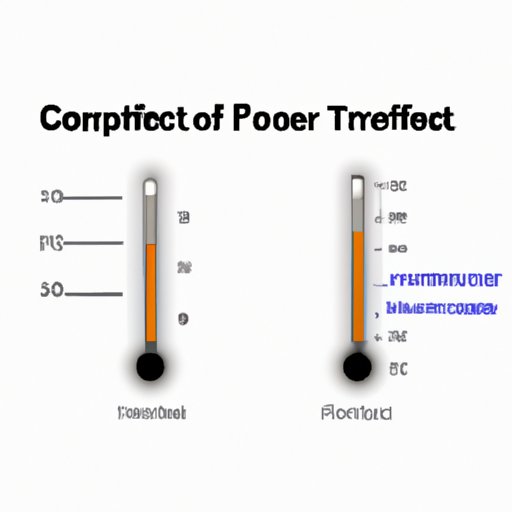Introduction
Have you ever found yourself in a situation where you needed to convert a temperature from Fahrenheit to Celsius? Whether you’re cooking, traveling, or simply trying to understand the weather, being able to convert temperatures is an essential skill. This article will provide you with a comprehensive guide on how to convert Fahrenheit to Celsius, including a breakdown of the formula, step-by-step instructions, common temperature points, conversion tools, scientific background, and real-world applications.
Provide a Simple Formula
The formula for converting Fahrenheit to Celsius is relatively simple. Take the temperature in Fahrenheit and subtract 32, then multiply by 5/9. The resulting number will be the temperature in Celsius. For example, if the temperature is 68 degrees Fahrenheit, the formula would be: (68-32) x 5/9 = 20 degrees Celsius.
Here is a table of popular temperature conversions to help you with quick reference:
| Fahrenheit | Celsius |
|---|---|
| 32 | 0 |
| 59 | 15 |
| 68 | 20 |
| 77 | 25 |
| 86 | 30 |
| 95 | 35 |
Steps to Convert Temperature
To convert Fahrenheit to Celsius, follow these simple steps:
- Write down the temperature in Fahrenheit that you want to convert.
- Subtract 32 from the Fahrenheit temperature.
- Multiply the result by 5/9.
- The resulting number is the temperature in Celsius.
For example, to convert 95 degrees Fahrenheit to Celsius:
- Write down 95 degrees Fahrenheit.
- Subtract 32: 95-32=63.
- Multiply by 5/9: 63 x 5/9=35.
- The temperature in Celsius is 35 degrees.
It is important to check your math using a calculator or a conversion tool to ensure accurate results.
Highlighting Common Temperature Points
Understanding common temperature points is essential for everyday life. Below are some common temperatures that people need to convert frequently:
- Freezing point of water: 32 degrees Fahrenheit or 0 degrees Celsius.
- Boiling point of water: 212 degrees Fahrenheit or 100 degrees Celsius.
- Room temperature: 68-72 degrees Fahrenheit or 20-22 degrees Celsius.
- Body temperature: 98.6 degrees Fahrenheit or 37 degrees Celsius.
To convert these temperatures, simply use the formula and follow the steps outlined above. A helpful tip for remembering these conversions is to associate them with a memory or image, such as picturing a thermometer in boiling water or ice.
Providing Conversion Tools
There are numerous online tools and calculators available to convert temperatures instantly. Here are some of the most popular:
- Convert Part – A simple and easy-to-use conversion tool with a clean interface.
- Rapid Tables – Provides more than just temperature conversions, including length, weight, and volume.
- The Calculator Site – Offers interactive tools and a wide range of conversion options.
When choosing a tool, consider factors such as accuracy, ease-of-use, and available features.
Explaining the Scientific Background
The Fahrenheit and Celsius temperature scales were invented by two scientists, Daniel Gabriel Fahrenheit and Anders Celsius, respectively. The Fahrenheit scale was originally based on the freezing and boiling points of a mixture of water, ice, and salt, while the Celsius scale was based on the freezing and boiling points of pure water at standard atmospheric pressure. The Celsius scale is now the global standard and is commonly used in scientific research and international communication. Understanding the scientific background of temperature conversion is important for accuracy and precision in certain applications, such as scientific research or engineering.
Relating Temperature Conversion to Real-World Applications
Temperature conversion has numerous practical applications in our daily lives. For example, cooking recipes from different countries may use different temperature scales, so knowing how to convert between Fahrenheit and Celsius is essential. Similarly, weather forecasters and meteorologists use temperature conversions to predict and report on weather conditions. Understanding temperature conversion can also help with energy efficiency and cost savings, as different temperature scales are used for heating and air conditioning systems in different parts of the world.
To apply temperature conversion in real life, practice using the formula and online tools, and make note of temperature conversions in recipes or weather reports.
Conclusion
Knowing how to convert Fahrenheit to Celsius is a valuable skill that has numerous practical applications. By understanding the formula, the steps to conversion, common temperature points, conversion tools, scientific background, and real-world applications, you can confidently and accurately convert temperatures to suit your needs. Whether you’re cooking, traveling, or simply curious about the weather, temperature conversion is an essential tool to have in your arsenal.
Practice with different temperatures and continue to apply temperature conversion in your daily life to strengthen your skills. With time and practice, you’ll be a temperature conversion expert in no time.
